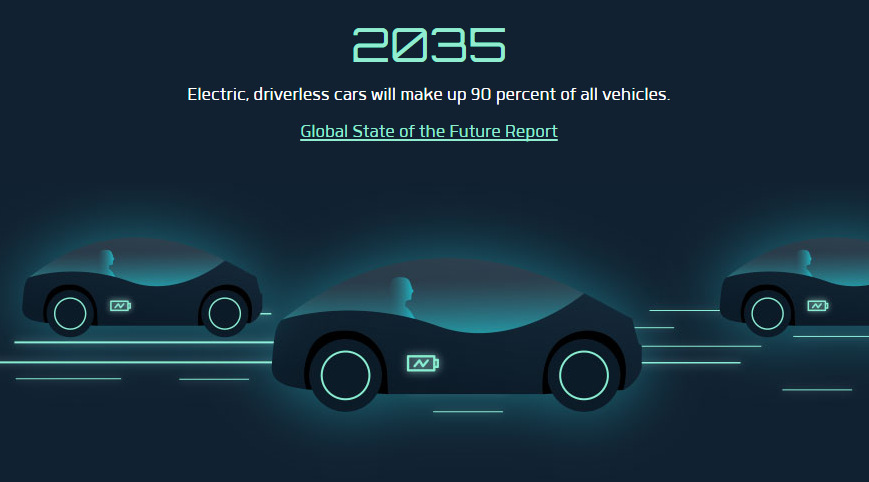Technology
Interactive: What Futuristic Transport Will You See in Your Lifetime?
What Futuristic Transport Will You See in Your Lifetime?
We are on the cusp of a revolution in transportation.
While there are still no flying cars yet, perhaps that is for the better.
Instead, it is the integrated application of ultra-fast processors, high-tech sensors, the sharing economy, battery technology, and deep learning that will revolutionize how automobiles operate.
The impact will be profound: by 2035, 90% of cars are expected to be driverless and electric. Further, even the ownership of cars will likely be a thing of the past.
The Future of Transportation
Today’s interactive piece comes to us from RS Components, and it shows how the technology around transportation will change in our lifetimes.
And it’s not just driverless cars that are taking over.
For example, Hyperloop One and skyTran are two interesting transportation projects that could online in the next 10 years, changing how we move between cities. Originally based off Elon Musk’s famous 2013 whitepaper, the first commercial Hyperloop is expected to allow travellers to move between Dubai and Abu Dhabi in just 12 minutes. For smaller distances, the skyTran will be a new system of monorail that could travel up to 150 mph (240 kph) above existing roads, using very little energy.
Further into the future, the world of transportation will be very different.
If you thought in-flight WiFi is cool, then the future of flight in 2050 will be even more surreal. Airbus predicts that panoramic windows, holographic communications and entertainment hubs, and sonic disruptors will allow people to observe, chat, and be entertained via in-flight experiences without disrupting other passengers.
Around the same time, Japanese corporation Obayashi is planning for its space elevator to be built and operational, stemming directly from the Earth’s equator. Using a 60,000 mi (96,000 km) carbon nanotube cable, a 1,300 ft (400 m) diameter floating Earth Port, and a 12,500 ton counter-weight, it would ship people and objects into space at an extremely low cost.
Such a feat of engineering and technology would revolutionize how we approach space travel.
Technology
Visualizing AI Patents by Country
See which countries have been granted the most AI patents each year, from 2012 to 2022.

Visualizing AI Patents by Country
This was originally posted on our Voronoi app. Download the app for free on iOS or Android and discover incredible data-driven charts from a variety of trusted sources.
This infographic shows the number of AI-related patents granted each year from 2010 to 2022 (latest data available). These figures come from the Center for Security and Emerging Technology (CSET), accessed via Stanford University’s 2024 AI Index Report.
From this data, we can see that China first overtook the U.S. in 2013. Since then, the country has seen enormous growth in the number of AI patents granted each year.
| Year | China | EU and UK | U.S. | RoW | Global Total |
|---|---|---|---|---|---|
| 2010 | 307 | 137 | 984 | 571 | 1,999 |
| 2011 | 516 | 129 | 980 | 581 | 2,206 |
| 2012 | 926 | 112 | 950 | 660 | 2,648 |
| 2013 | 1,035 | 91 | 970 | 627 | 2,723 |
| 2014 | 1,278 | 97 | 1,078 | 667 | 3,120 |
| 2015 | 1,721 | 110 | 1,135 | 539 | 3,505 |
| 2016 | 1,621 | 128 | 1,298 | 714 | 3,761 |
| 2017 | 2,428 | 144 | 1,489 | 1,075 | 5,136 |
| 2018 | 4,741 | 155 | 1,674 | 1,574 | 8,144 |
| 2019 | 9,530 | 322 | 3,211 | 2,720 | 15,783 |
| 2020 | 13,071 | 406 | 5,441 | 4,455 | 23,373 |
| 2021 | 21,907 | 623 | 8,219 | 7,519 | 38,268 |
| 2022 | 35,315 | 1,173 | 12,077 | 13,699 | 62,264 |
In 2022, China was granted more patents than every other country combined.
While this suggests that the country is very active in researching the field of artificial intelligence, it doesn’t necessarily mean that China is the farthest in terms of capability.
Key Facts About AI Patents
According to CSET, AI patents relate to mathematical relationships and algorithms, which are considered abstract ideas under patent law. They can also have different meaning, depending on where they are filed.
In the U.S., AI patenting is concentrated amongst large companies including IBM, Microsoft, and Google. On the other hand, AI patenting in China is more distributed across government organizations, universities, and tech firms (e.g. Tencent).
In terms of focus area, China’s patents are typically related to computer vision, a field of AI that enables computers and systems to interpret visual data and inputs. Meanwhile America’s efforts are more evenly distributed across research fields.
Learn More About AI From Visual Capitalist
If you want to see more data visualizations on artificial intelligence, check out this graphic that shows which job departments will be impacted by AI the most.
-

 Markets1 week ago
Markets1 week agoU.S. Debt Interest Payments Reach $1 Trillion
-

 Markets2 weeks ago
Markets2 weeks agoRanked: The Most Valuable Housing Markets in America
-

 Money2 weeks ago
Money2 weeks agoWhich States Have the Highest Minimum Wage in America?
-

 AI2 weeks ago
AI2 weeks agoRanked: Semiconductor Companies by Industry Revenue Share
-

 Markets2 weeks ago
Markets2 weeks agoRanked: The World’s Top Flight Routes, by Revenue
-

 Countries2 weeks ago
Countries2 weeks agoPopulation Projections: The World’s 6 Largest Countries in 2075
-

 Markets2 weeks ago
Markets2 weeks agoThe Top 10 States by Real GDP Growth in 2023
-

 Money2 weeks ago
Money2 weeks agoThe Smallest Gender Wage Gaps in OECD Countries















